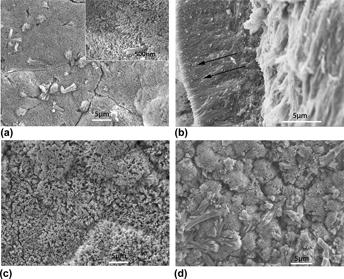Crossref Citations
This article has been cited by the following publications. This list is generated based on data provided by
Crossref.
2016.
Repairing human tooth enamel with leucine-rich amelogenin
peptide-chitosan hydrogel - Erratum Following iron speciation in the early
stages of magnetite magnetosome biomineralization - Erratum.
Journal of Materials Research,
Vol. 31,
Issue. 6,
p.
821.
Wang, Menghu
Xie, Hao
Xie, Jingjing
Ping, Hang
Tan, Tiening
Ji, Wei
and
Fu, Zhengyi
2017.
Fast mineralization of densely packed hydroxyapatite layers in the presence of overexpressed recombinant amelogenin.
Journal of Wuhan University of Technology-Mater. Sci. Ed.,
Vol. 32,
Issue. 2,
p.
256.
Ren, Qian
Li, Zhongcheng
Ding, Longjiang
Wang, Xiuqing
Niu, Yumei
Qin, Xi
Zhou, Xuedong
and
Zhang, Linglin
2018.
Anti-biofilm and remineralization effects of chitosan hydrogel containing amelogenin-derived peptide on initial caries lesions.
Regenerative Biomaterials,
Vol. 5,
Issue. 2,
p.
69.
Hozumi, Kentaro
and
Nomizu, Motoyoshi
2018.
Mixed Peptide-Conjugated Chitosan Matrices as Multi-Receptor Targeted Cell-Adhesive Scaffolds.
International Journal of Molecular Sciences,
Vol. 19,
Issue. 9,
p.
2713.
Prajapati, S.
Ruan, Q.
Mukherjee, K.
Nutt, S.
and
Moradian-Oldak, J.
2018.
The Presence of MMP-20 Reinforces Biomimetic Enamel Regrowth.
Journal of Dental Research,
Vol. 97,
Issue. 1,
p.
84.
Zhou, Yang
Zhou, Yanling
Gao, Long
Wu, Chengtie
and
Chang, Jiang
2018.
Synthesis of artificial dental enamel by an elastin-like polypeptide assisted biomimetic approach.
Journal of Materials Chemistry B,
Vol. 6,
Issue. 5,
p.
844.
Mukherjee, Kaushik
Ruan, Qichao
Nutt, Steven
Tao, Jinhui
De Yoreo, James J.
and
Moradian-Oldak, Janet
2018.
Peptide-Based Bioinspired Approach to Regrowing Multilayered Aprismatic Enamel.
ACS Omega,
Vol. 3,
Issue. 3,
p.
2546.
Cougot, Nancie
Douillard, Thierry
Dalmas, Florent
Pradelle, Nelly
Gauthier, Rémy
Sanon, Clarisse
Grosgogeat, Brigitte
Colon, Pierre
and
Chevalier, Jérome
2018.
Towards quantitative analysis of enamel erosion by focused ion beam tomography.
Dental Materials,
Vol. 34,
Issue. 11,
p.
e289.
Singh, Sidhartha
Kumar, Sandeep
and
Yata, Vinod Kumar
2019.
Environmental Nanotechnology.
Vol. 21,
Issue. ,
p.
109.
Chen, Zhuoxin
Miao, Zhangshu
Zhang, Pan
Xiao, Hong
Liu, Huan
Ding, Chunmei
Tan, Hong
and
Li, Jianshu
2019.
Bioinspired enamel-like oriented minerals on general surfaces: towards improved mechanical properties.
Journal of Materials Chemistry B,
Vol. 7,
Issue. 34,
p.
5237.
Ikono, Radyum
Li, Ni
Pratama, Nanda Hendra
Vibriani, Agnia
Yuniarni, Diah Retno
Luthfansyah, Muhammad
Bachtiar, Boy Muchlis
Bachtiar, Endang Winiati
Mulia, Kamarza
Nasikin, Mohammad
Kagami, Hideaki
Li, Xianqi
Mardliyati, Etik
Rochman, Nurul Taufiqu
Nagamura-Inoue, Tokiko
and
Tojo, Arinobu
2019.
Enhanced bone regeneration capability of chitosan sponge coated with TiO2 nanoparticles.
Biotechnology Reports,
Vol. 24,
Issue. ,
p.
e00350.
Pandya, Mirali
and
Diekwisch, Thomas G. H.
2019.
Enamel biomimetics—fiction or future of dentistry.
International Journal of Oral Science,
Vol. 11,
Issue. 1,
Mukherjee, Kaushik
Ruan, Qichao
and
Moradian-Oldak, Janet
2019.
Odontogenesis.
Vol. 1922,
Issue. ,
p.
129.
Wang, Shengrui
Zhang, Le
Chen, Wendy
Jin, Huimin
Zhang, Ya
Wu, Leping
Shao, Hui
Fang, Zehui
He, Xiaoxue
Zheng, Shunli
Cao, Chris Ying
Wong, Hai Ming
and
Li, Quanli
2020.
Rapid regeneration of enamel-like-oriented inorganic crystals by using rotary evaporation.
Materials Science and Engineering: C,
Vol. 115,
Issue. ,
p.
111141.
Mukherjee, Kaushik
Visakan, Gayathri
Phark, Jin-Ho
and
Moradian-Oldak, Janet
2020.
Enhancing Collagen Mineralization with Amelogenin Peptide: Toward the Restoration of Dentin.
ACS Biomaterials Science & Engineering,
Vol. 6,
Issue. 4,
p.
2251.
Hanafy, Rania Ahmed
Mostafa, Dawlat
Abd El-Fattah, Ahmed
and
Kandil, Sherif
2020.
Biomimetic chitosan against bioinspired nanohydroxyapatite for repairing enamel surfaces.
Bioinspired, Biomimetic and Nanobiomaterials,
Vol. 9,
Issue. 2,
p.
85.
Tang, Shuxian
Dong, Zhiyun
Ke, Xiang
Luo, Jun
and
Li, Jianshu
2021.
Advances in biomineralization-inspired materials for hard tissue repair.
International Journal of Oral Science,
Vol. 13,
Issue. 1,
Ayala-Ham, Alfredo
López-Gutierrez, Jorge
Bermúdez, Mercedes
Aguilar-Medina, Maribel
Sarmiento-Sánchez, Juan Ignacio
López-Camarillo, César
Sanchez-Schmitz, Guzman
and
Ramos-Payan, Rosalio
2021.
Hydrogel-Based Scaffolds in Oral Tissue Engineering.
Frontiers in Materials,
Vol. 8,
Issue. ,
Kamnoore, Devanand
Mukherjee, Dhrubojyoti
Nayak Ammunje, Damodar
Parasuraman, Pavadai
Teja, Banala Venkatesh
and
Radhika, M.
2021.
Hydroxyapatite nanoparticle-enriched thiolated polymer-based biocompatible scaffold can improve skin tissue regeneration.
Journal of Materials Research,
Vol. 36,
Issue. 21,
p.
4287.
Mukherjee, Kaushik
Chakraborty, Amrita
Sandhu, Garima
Naim, Sohaib
Bauza Nowotny, E.
and
Moradian-Oldak, Janet
2021.
Amelogenin Peptide-Chitosan Hydrogel for Biomimetic Enamel Regrowth.
Frontiers in Dental Medicine,
Vol. 2,
Issue. ,





